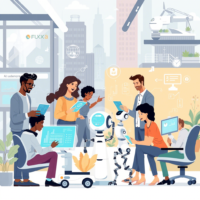Introduction
Start with a compelling introduction that hooks the reader and sets the stage for the discussion. Use storytelling or thought-provoking questions to engage your audience.
“By 2025, artificial intelligence (AI) will no longer be just a buzzword—it will be the backbone of industries, economies, and daily life. From self-driving cars to personalized healthcare, AI is set to revolutionize the way we live, work, and interact. But what exactly does the future hold? What are the key trends, innovations, and challenges we can expect? And how can individuals and businesses prepare for this AI-driven transformation?
In this comprehensive guide, we’ll explore the future of AI in 2025, diving deep into emerging technologies, their potential impact on various sectors, and the ethical considerations that come with them. Whether you’re a tech enthusiast, business leader, or curious individual, this article will provide valuable insights into the next frontier of artificial intelligence.”
Section 1: Key AI Trends Shaping 2025
Subsection 1.1: Generative AI (H3)
- Explain generative AI and its applications, such as creating realistic images, videos, and text.
- Discuss tools like GPT-4, DALL-E, and their successors.
- Highlight use cases in marketing, entertainment, and design.
Subsection 1.2: Quantum Machine Learning (H3)
- Define quantum computing and its role in accelerating machine learning algorithms.
- Discuss potential breakthroughs in solving complex optimization problems.
- Provide examples like drug discovery and climate modeling.
Subsection 1.3: Explainable AI (XAI) (H3)
- Emphasize the importance of transparency in AI decision-making.
- Explain how XAI helps build trust and accountability.
- Mention industries where explainability is critical, such as healthcare and finance.
Subsection 1.4: Edge AI (H3)
- Define edge AI and its benefits over cloud-based systems.
- Discuss real-time processing and reduced latency.
- Highlight applications in IoT devices, autonomous vehicles, and smart cities.
Section 2: How AI Will Transform Industries by 2025
Subsection 2.1: Healthcare (H3)
- AI-powered diagnostics and personalized medicine.
- Predictive analytics for disease prevention.
- Examples: AI-assisted surgeries and virtual health assistants.
Subsection 2.2: Finance (H3)
- Fraud detection and risk management.
- Algorithmic trading and robo-advisors.
- The rise of decentralized finance (DeFi) powered by AI.
Subsection 2.3: Education (H3)
- Personalized learning platforms tailored to individual needs.
- Virtual tutors and immersive learning experiences.
- Bridging the education gap in underserved communities.
Subsection 2.4: Transportation (H3)
- Autonomous vehicles and smart traffic management.
- AI in logistics and supply chain optimization.
- Environmental benefits of AI-driven transportation systems.
Subsection 2.5: Retail and E-commerce (H3)
- Hyper-personalized shopping experiences.
- Inventory management and demand forecasting.
- AI chatbots enhancing customer service.
Section 3: Challenges and Ethical Concerns of AI in 2025
Subsection 3.1: Job Displacement and Workforce Transformation (H3)
- Automation replacing repetitive tasks across industries.
- The need for reskilling and upskilling workers.
- Balancing efficiency gains with employment opportunities.
Subsection 3.2: Bias in AI Algorithms (H3)
- Examples of biased AI systems and their consequences.
- Efforts to create fair and inclusive AI models.
- The role of diverse datasets in reducing bias.
Subsection 3.3: Data Privacy and Security (H3)
- Risks associated with AI’s reliance on vast amounts of data.
- Regulations like GDPR and their impact on AI development.
- Strategies for safeguarding user information.
Subsection 3.4: Autonomous Weapons and Misuse (H3)
- The dangers of AI-powered military technologies.
- International efforts to regulate lethal autonomous weapons.
- Preventing misuse of AI in cyberattacks and surveillance.
Section 4: Top Innovations Driving AI Growth by 2025
Subsection 4.1: Neuromorphic Chips (H3)
- Mimicking the human brain for faster and more efficient processing.
- Applications in robotics and real-time AI systems.
Subsection 4.2: Federated Learning (H3)
- Training AI models without sharing sensitive data.
- Use cases in healthcare and finance.
Subsection 4.3: Advanced Robotics (H3)
- Collaborative robots (cobots) working alongside humans.
- Robots in manufacturing, agriculture, and eldercare.
Subsection 4.4: Natural Language Processing (NLP) (H3)
- Breakthroughs in understanding and generating human language.
- Multilingual AI systems breaking down communication barriers.
Section 5: Preparing for an AI-Driven Future in 2025
Subsection 5.1: For Businesses (H3)
- Adopting AI strategically to improve efficiency and innovation.
- Investing in employee training and development.
Subsection 5.2: For Individuals (H3)
- Embracing lifelong learning to stay relevant in the job market.
- Exploring careers in AI-related fields.
Subsection 5.3: For Governments (H3)
- Developing policies to regulate AI responsibly.
- Promoting equitable access to AI technologies.
Conclusion :
Summarize the key points discussed in the article and reiterate the transformative potential of AI in 2025. End with a call-to-action encouraging readers to stay informed and proactive.
“As we approach 2025, the future of artificial intelligence promises unprecedented advancements and opportunities. From revolutionizing industries to addressing global challenges, AI has the power to reshape our world. However, with great power comes great responsibility. It’s crucial for individuals, businesses, and governments to prepare for this AI-driven era by embracing innovation while addressing ethical concerns. Stay ahead of the curve by keeping up with the latest developments and contributing to a future where AI benefits all of humanity.”

